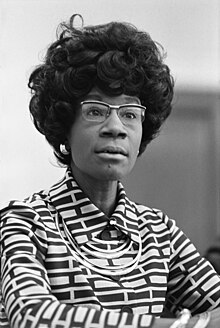Let’s talk about women in politics.
Ramping up to the 2016 caucuses, we have two female presidential candidates: Carly Fiorina (R) and Hillary Clinton (D). Carly Fiorina, formerly the CEO of Hewlett-Packard (HP), had gained early steam in the Republican presidential debates proving herself with actual policies and plans — but has fallen out of favor in the polls. Hillary Clinton, former First Lady, Secretary of State, and US Senator, is not new to the presidential race and is facing tough numbers as of late against Bernie Sanders.
In my Millennial mind, I’m thinking, “Finally! The first time there are two female presidential contenders!” To my great surprise, this is not true.
Pioneering Women of American Congress
Back in 1972, two groundbreaking women took a chance at becoming the first female — and minority — president: Shirley Chisholm, the first Black woman elected to Congress, and Patsy Mink, the first Asian-American woman elected to Congress.

Shirley Chisholm (D-NY)
An educator turned politician, she ran her US congressional race in Brooklyn back in 1968 under the slogan “unbought and unbossed.” She was like an original political outsider, irking the status quo politicians of the late sixties: old, male and white. But that didn’t dismay her; just like in her slogan, she worked her way onto the Education and Labor Commitees and championed early education and child welfare.
When she began her political career, running for NY state legislature, she saw a need for the people to be truly represented and fight for their needs. A skilled debater in college, Chisholm had the prowess to enter a tough political atmosphere and make a difference. She helped establish the WIC program, the Congressional Black Caucus, and the National Women’s Political Caucus.
—

Patsy Mink (D-HI)
As a high-achieving Japanese-American high school student in WWII Hawaii, who was class president and valedictorian, it’s hard not to see Patsy Takemoto Mink’s bright future in politics. She fought and beat segregation policies at University of Nebraska by building coalitions between the students, faculty, parents, and even corporations. This ability to unite different stakeholders played a strong role in her political career: solidifying the Democratic Party’s stance on civil rights in 1960, championing Title IX and introducing the Early Childhood Act and Women’s Educational Equality Act. She also readily questioned the creation of the Department of Homeland Security with concerns of people’s civil rights, citing what she had witnessed of the Japanese internment camps in her youth.
And there have been women before them who ran campaigns on small party tickets going back to 1872 with Victoria Woodhull of the Equal Rights Party — she went on to be the first woman to own a Wall Street investment firm. Other noteworthy names would be Elizabeth Dole (D), who ran in the 2000 election, and Michelle Bachmann (R) who ran in the 2012 election for Republican nominee.
It’s Time to See an American Woman for President
56% of Americans believe that we’ll have a female president in the next decade, according to a MAKERS/HuffPost poll from November 2015. Isn’t it inevitable?

Countries that have had: Female Head of Gov’t (yellow), Female Head of State (blue), Female Head of State/Gov’t Combined (light green), Female Head of State & Female Head of Gov’t (dark green) Source: Wikipedia
America is behind compared to the rest of the world. Pivotal women leaders of the past like Isabel Peron of Argentina, Indira Gandhi of India, Margaret Thatcher of the UK and Sirimavo Bandaranaike of Sri Lanka helped pave the way for the 13 female presidents and 9 female prime ministers currently in power today. In my mother’s home country of Indonesia, they had their first female president Megawati Sukarnoputri in 2001 — and she was only their 5th president! The Philippines have had two women lead already: Corazon Aquino and Gloria Macapagal-Arroyo. We are behind in the parity of diversity and equality in our elected leaders, especially for being a nation that promotes it like we do.
A Future We Can Believe In
I’m confident that America will continue to improve its numbers of women in political leadership positions. It starts with fostering more politically active women and providing opportunities to make a difference. Currently, 19.4% of Congress are women (104 out of 525) and out of the 104, 33 are either African-American, Latina or Asian-Pacific Islander. These numbers may seem paltry, but this is part of a continuing upward trend of more women in political leadership positions. With more women leaders come more diversity of thought and voices in our government, providing more solutions for our increasingly diverse nation. Underrepresented groups are gaining more share of political power and a seat at the table to have their voices heard.
But this only happens if we vote them in. Although the political process can seem daunting, remember that they are in charge of representing your ideals and spending your hard earned tax dollars. Each vote helps determine what bills get funded, what becomes important in this nation and what our future looks like. Democracy is supposed to be an active process and I hope this helps you gain a small glimpse into our reality of women political leaders in America and around the world. Progress comes one step at a time and it takes people who are willing to become educated and engage in discourse with those across the political spectrum to advance it. Vote people into office who are equipped with the knowledge, experience, and the savvy to move our country forward to better us now and in the future.
Remember, Internet, become a truly educated voter this election year. Fact-check, read up, and plug in.
Cheers, Amelia
###
Unrequired Reading:
Center for American Women and Politics, Eagleton Institute of Politics, Rutgers University
Worldwide Guide to Women in Leadership
UN Women: Facts and Figures
